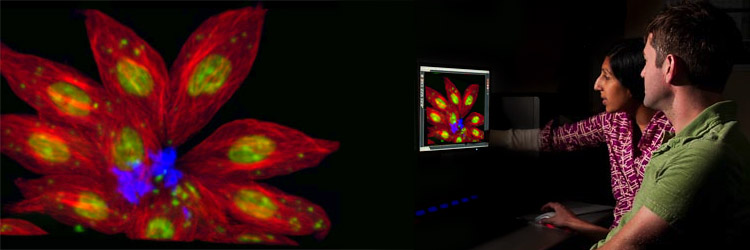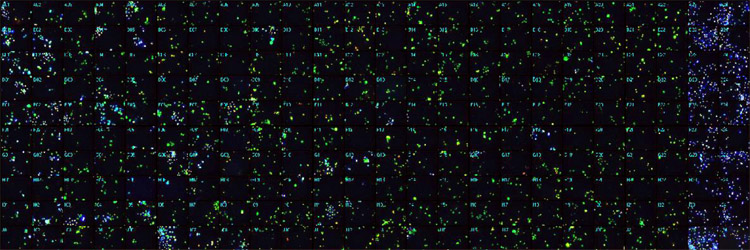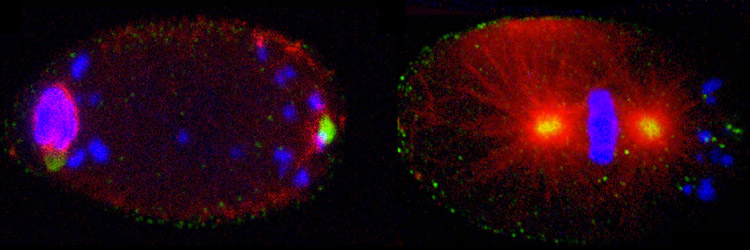 |
The Sullivan Lab, MCD Biology, UCSC |




| |||
Sullivan Lab Research Wolbachia and the Biology of Host-pathogen Interactions
What are Wolbachia? Wolbachia are gram-negative, obligate, intracellular bacteria carried by millions of arthropod and nematode hosts worldwide. The success of Wolbachia is largely a result of its ability to be efficiently transmitted through through the female lineage and its ability to manipulate host reproduction such that infected females are at a selective advantage over uninfected females. Wolbachia are present in a variety of somatic tissues and exhibit highest concentrations in the male and female germline. Like mitochondria, Wolbachia are exclusively transmitted through the female germline. Stable transmission requires that Wolbachia maintain a presence in the germline stem cells and are able to navigate the dramatic cytoskeletal rearrangements that drive oogenesis in order to concentrate in the posterior of the mature oocyte. Efficient maternal transmission also requires Wolbachia regulate its replication to insure all eggs are infected, while minimizing disruption of normal oocyte development. A focus of our lab is to identify the host factors required for Wolbachia transmission and replication during oogenesis. Wolbachia have an extraordinary ability to alter development and reproduction to favor females. This includes male killing, inducing parthenogenesis and sex reversal (Wolbachia infected males develop into females). The most common form of altered reproduction is CI, a conditional sterility resulting from crosses of Wolbachia-infected males to uninfected females. Inviable embryos are produced due to defects in the first zygotic division Significantly if both females and males are infected, viable embryos are produced. This phenomenon, known as Rescue, favors infected females over uninfected females resulting in the rapid spread of Wolbachia through populations. Our lab relies on a combination of bio-informatic, genetic and cellular approaches to understand the molecular basis of this phenomenon. Wolbachia are closely related to Rickettsia, a family of tick-borne pathogens that cause disease, such as Rocky Mountain spotted fever Wolbachia have also been linked to disease via their symbiotic relationship with pathogenic nematodes, such as Brugia malayi, known for causing elephantiasis, and Onchocerca volvulus, associated with the condition Onchocerciasis (river blindness. Recent evidence has implicated Wolbachia directly as the cause of ocular inflammation associated with river blindness, a condition that affects millions of people worldwide. This discovery has led to the realization that antibiotic therapy is an effective means of combating these neglected diseases. Consequently there is a great need to identify new potent compounds that specifically target Wolbachia. To this end, we have a developed high-throughput cell-based screen to identify new anti-Wolbachia drugs. Representative Wolbachia Publications: Landmann F, Foster J.M, Michalski S, Slatko BE, Sullivan W (2014) Co-evolution between an endosymbiont and its nematode host: Wolbachia asymmetric posterior localization and AP polarity establishment. PLOS Negl Trop Dis Aug; 8(8): e3096. [PDF] Albertson RJ, Tan V, Leads RR, Reyes M, Sullivan W, Casper-Lindley C (2013) Mapping Wolbachia distributions in the adult Drosophila brain. Cell Microbiol. [PDF] Serbus LR*, Landmann F*, Bray WM, White PM, Ruybal J, Lokey RS, Debec A, Sullivan W. (2012) A Cell-Based Screen Reveals that the Albendazole Metabolite, Albendazole Sulfone, Targets Wolbachia. PLoS Pathog. Sep;8(9):e1002922. [PDF] Landmann F, Foster JM, Slatko B, Sullivan W. (2010) Asymmetric Wolbachia segregation during early Brugia malayi embryogenesis determines its distribution in adult host tissues. PLoS Negl Trop Dis. 27;4(7):e758. [PDF] For a complete list of Wolbachia-related publications, see our main Publications page. [Next] [Sullivan Research Main Page ] |
|||
|
|